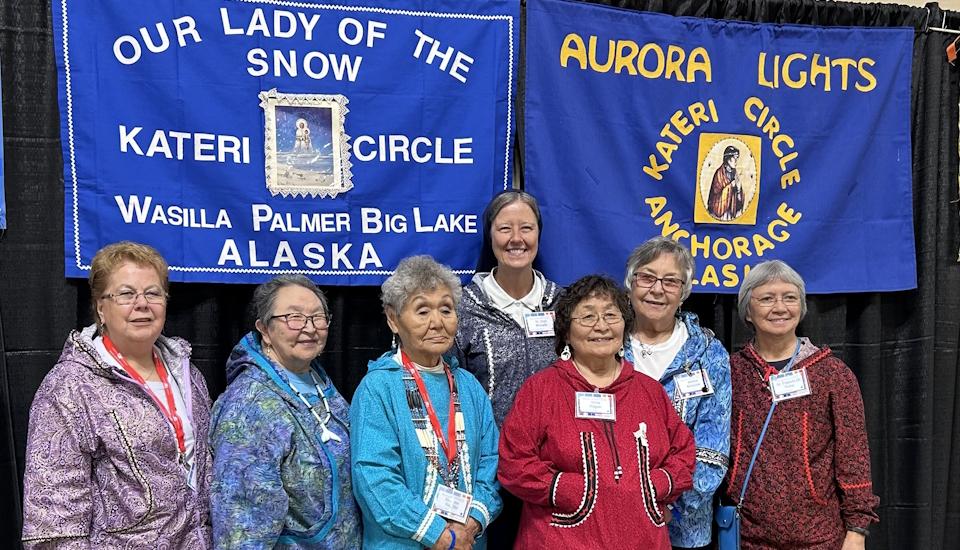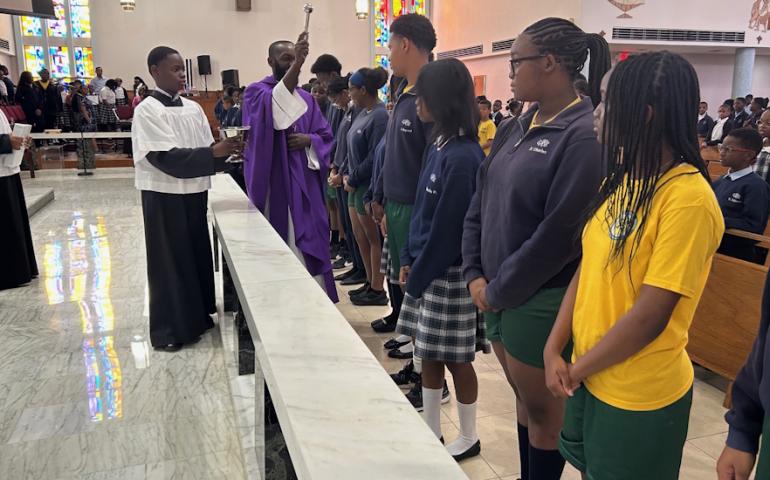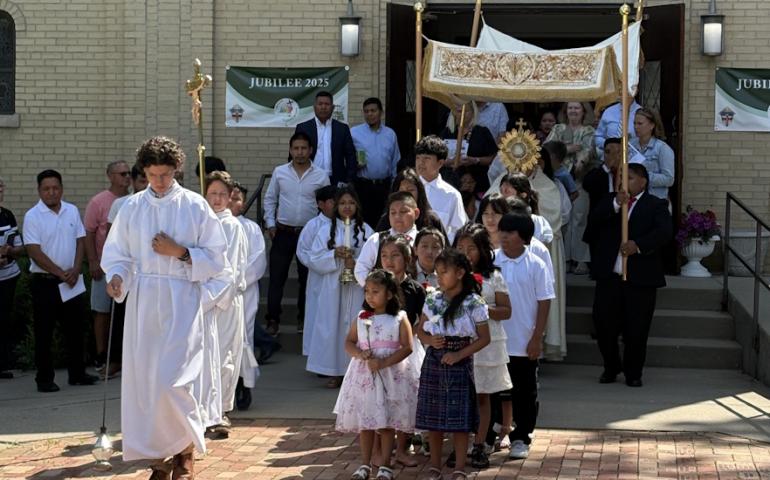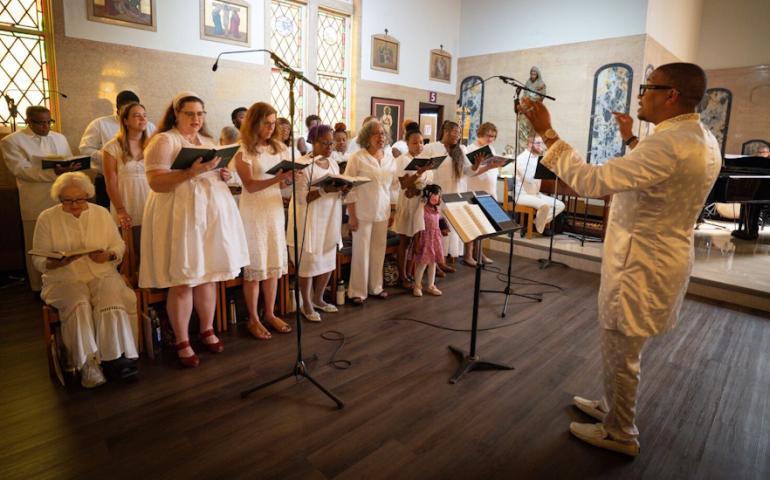
Anchorage-Juneau
By Levi Livengood
Sr. Jean Rhoads, D.C., who heads the archdiocesan Office of Native Ministries, attended the annual Tekakwitha Conference in Las Cruces, New Mexico July 16–20. She recalled how there were 330 attendees at the event in the Las Cruces Convention Center, including several from our own community, such as Ruth Stewart from Wasilla, Gemma Gaudio, Emma Haggan, Aimee Aloysius, and her sister, Renee Nicholson.
Sr. Jean said it was beautiful and exciting “to see [the attendees’] genuine desire to deepen their faith.” Likewise, she said it was a “beautiful opportunity to be with and experience different Native cultures, including Alaska Native cultures.”
The Tekakwitha Conference developed from 1977–1980 out of a Northern Plains Catholic Indian missionaries group founded in 1939, according to Marquette University.
The purpose of the conference is simple. She said it is to “celebrate Native culture, deepen the faith, and celebrate the life of St. Kateri Tekakwitha.”
St. Kateri Tekakwitha holds the honor of being the first Native American saint to be canonized who lived within the lands now referred to as the United States of America, beatified in 1980 by St. Pope John Paul II. She, along with other Indigenous saints such as St. Juan Diego and the Martyrs of Tlaxcala, are much revered.
St. Kateri Tekakwitha, who lived from 1656–1680 in what is now New York State, is also known as the “Lily of the Mohawks.” According to the website of the national shrine and historic site dedicated to her, she was born in Ossernenon, near modern Auriesville, New York, to a Mohawk chief, one of the constituent tribes of the Iroquois Confederacy, and his Christian Algonquin war-bride.
At four years old, smallpox killed many in her village, including her father, mother, and brother, leading to her adoption by her aunt, the wife of a prominent figure in the Mohawk Turtle Clan, and her scarred face and darkened vision, possibly giving rise to the name, Tekakwitha, which means “she who bumps into things.”
Following a French-led raid of Mohawk settlements south of the Mohawk River, her family followed other survivors northward where they founded Caughnawaga in 1666, where she mastered beadwork and basketweaving, doing small handiwork for her community.
Despite her engagement at 13, her confessor states that she said, “I can have no spouse but Jesus. I have the strongest aversion to marriage.”
Peace with the French brought Jesuits into Mohawk settlements. At 18, Tekakwitha was instructed by Fr. Jacques de Laberville in the faith. He wrote much about her, including her being well-behaved, and that she did all she could to remain holy in her secular society, leading to conflict with her neighbors. She was baptized in 1676 with water from the spring still present at the shrine when she also took the name “Kateri” to honor St. Catherine of Siena.
By her death in 1680, Kateri had received First Communion and made a vow of perpetual virginity, which was not recognized by the bishop. She and another Native woman, Marie Thérèse Tegaianguenta, proposed that a Native religious order be created, though the Jesuits rejected this.
Her last words were “Jesus, Mary, I love you,” and within four years pilgrimages to her tomb began along with the attribution of healing miracles.
Sr. Jean said one of the highlights of the conference was the presentation of a “beautiful film on her life and canonization.” She was very impressed by the “genuineness of her faith.” Sr. Jean said, “She did not mind being criticized or mocked.” Sr. Jean recounted the story of how, shortly after her death, St. Kateri’s face was miraculously healed of smallpox, leading to the adoption of her title, “Lily of the Mohawks.”
St. Kateri Tekakwitha’s example is a powerful one, as are her miraculous works.
Sr. Jean explained how the film also showed an interview of Sr. Kateri Mitchell, S.S.A., a member of the Mohawk Nation at Akwesasne who served as executive director of the Tekakwitha Conference from 1998–2017, according to Marquette University.
According to Sr. Kateri Mitchell, S.S.A., in 2006, the mother of a six-year-old boy, Jacob (Jake) Finkbonner, suffering from a flesh-eating disease requested that she bring a relic of St. Kateri Tekakwitha to place on her son’s face.
Sr. Kateri assented to this request, but modified it slightly, asking that she and the mother place the relic on the boy’s leg, both pressing down on it. They did this while Jake was staying at Seattle Children’s Hospital, praying for the intercession of St. Kateri Tekakwitha. Subsequently, a disease that was to be fatal was itself vanquished and the boy healed.
A Vatican-authenticated miracle, the physician who verified it, Dr. Mary was also present at the conference.
Sr. Jean said it was beautiful to see Finkbonner grown up on film and see that he was studying in residence in order to perform plastic surgery, and to see the joy for the canonization from Native people all over.
Another highlight for Sr. Jean was listening to the talk by 14-year-old Joshua Penya, present for the saint’s canonization in Rome in 2012, who talked about how he asked St. Kateri Tekakwitha to intervene and save his grandfather’s life, a prayer which was answered.
He then spoke about how his experience as an altar server had deepened his understanding of God through the Mass, unveiling its authentic wealth of meaning, rather than the rote ritual it can be mistaken for. He realized he was truly helping with a sacred celebration and that it was important to pass down and love our faith.
Sr. Jean said he was such a powerful speaker the audience cried: “He was just so dear.”
Additionally, a service for healing and reconciliation was offered, facilitated by clergy, including bishops, who offered the sacrament of Reconciliation. Laypeople also were present, offering healing prayers.
Sr. Jean said her role “is to listen, learn, and celebrate who they are and their cultures.” “That should be the whole point.” She hopes that more people continue to participate in what the archdiocesan Office of Native Ministries offers to the faithful, including weekly Kateri Circle Meetings at St. Anthony parish in Anchorage, Sacred Heart parish in Wasilla, and St. Michael parish in Palmer, the 11:30 Sunday Mass at the Alaska Native Medical Center, the monthly Third Saturday Vigil Mass at St. Anthony parish, and more.
She also hopes that more young Native people will be encouraged to attend these events, following in the examples of people like Penya, Finkbonner, people in their own communities, and St. Kateri Tekakwitha herself, coming to value their faith and the unique way in which it blooms, planted in the soil of their cultures, much like the Lily of the Mohawk did three centuries ago.





